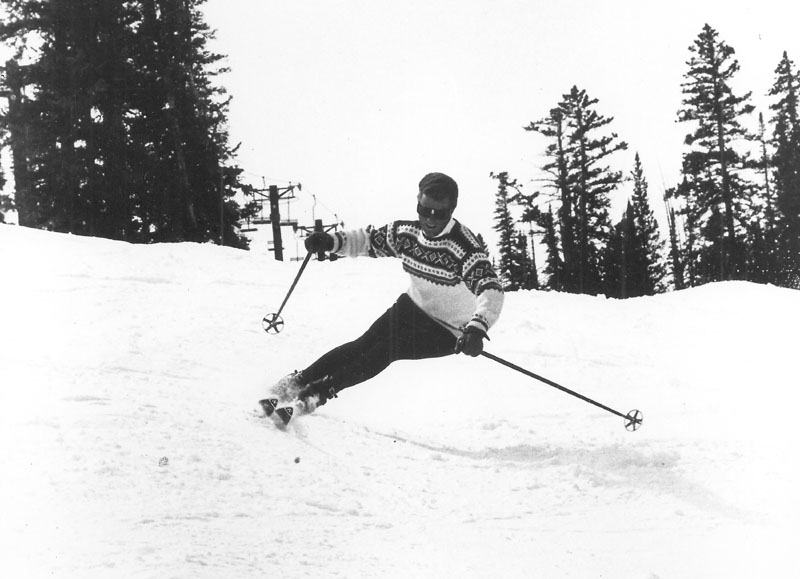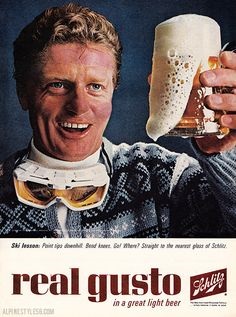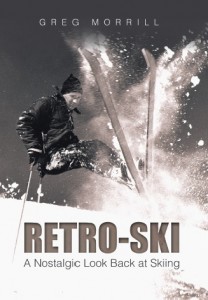There was an old joke that went something like this:
A skier passed away and was awaiting St. Peter’s approval to get into heaven when he spotted what looked like Stein Eriksen carving beautiful arcs on the side of a cloud.
“Wow!” the newcomer exclaimed. “I didn’t know Stein was here!”
“Oh, that’s not Stein,” says St. Peter. “That’s God. He just wants to be like Stein!”
Yes, if you were a Retro-Skier, you wanted to be like Stein. Or at least all the men wanted to be like Stein. All the women wanted to be with Stein!
Last week I started a two part series on Stein Eriksen. My teaser trivia question had been what do Sugarbush and Deer Valley have in common. Due to early submission dates for the Holidays, I wasn’t able to give credit to those who answered the trivia. Two of my long-time friends and skiing buddies, Mike Weisel and Glen Findholt named Stein as the link between the two areas. Mike, Glen, and I were fraternity brothers at UNH. Yes, that long ago! Lyndall Heyer also recognized Stein as the common link I was looking for.

What did it mean to be like Stein? Well, first there was the way he skied. The skis, boots, and legs were locked together. You never saw any daylight between his legs no matter what maneuver he was executing. I remember holding my ski hat between my knees to practice keeping my legs together. Nothing like having to hike back up the hill to retrieve your hat a few times to help you achieve that locked leg technique. People who see me ski today probably still would say my skis are close together, but trust me, they are further apart now than at any time in those early years.
Then there was the exaggerated counter-rotation of Stein’s upper body. At speed this allowed Stein to hang his hips over the slope at a gravity-defying angle. All you needed to see was a silhouette in this position and you knew it was Stein. The first time I ever achieved that same feeling was skiing down Spar Gulch at Aspen. That trail has banked sides sort of like a natural halfpipe although not as steep. I found that with some speed I could bank a turn off the sides and with counter-rotation hang my butt over the downhill side of the bank.
However just being able to achieve the same position as Stein didn’t mean you skied like Stein. Stein did everything with ease and grace. Stein said “To me, gracefulness on skis should be the end-all of the sport…” And nobody was more graceful than Stein!
We also had to dress like Stein. I’ve talked about the “uniform” before: in-the-boot stretch pants, turtle neck, wind shirt, ski sweater, and for cold days a parka. The goal was to ski in a sweater any time it was possible. Almost every picture of Stein showed him skiing in a sweater. The style was even referred to as a “Stein” sweater. And you never saw Stein skiing in a hat! So any time you could ski in a sweater, you’d also lose the hat. There’s a rumor that the reason Stein left Sugarbush was the cold winters that limited the amount of time he could ski in a sweater and no hat!
Stein did have one asset that most of us could only envy: his good looks. He was a blonde-haired, blue-eyed Norse god. As skiing gained popularity in the 1950s and 60s, Stein was the face of the sport. I recently found a video of a 1960 advertisement for the Chevy Corvair that featured Stein racing a Corvair down a ski trail!
Speaking of advertisements, Martha Turek previously shared a story of one advertising campaign featuring Stein that didn’t last long. Stein did a television ad for Schlitz beer where he would joyfully say “Have a glass of Schlitz!”, but with his accent it seemed to deliver a different message.
Martha actually knew Stein personally. Martha’s father opened the first ski shop in Hartford, Connecticut, and Stein worked there when he came to the United States in 1949. That was before Martha was born, but she remembers Stein, whom she called “Uncle Stein”, visiting them during the 1950s and 60s whenever he was in New England.


Leave a Reply